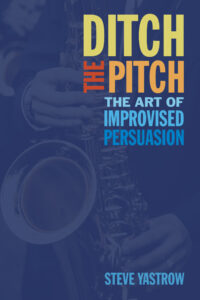One of my beliefs is that everyone can benefit from understanding sales techniques. I simplify it to say, “We are all in sales.”
Whether you actually are a sales professional or not, you will find that successful people understand sales techniques and use them in everyday life.
- Need funding for a new business?
- Growing your platform?
- Need to convince your kids to eat more veggies?
Steve Yastrow is the author of Ditch the Pitch, a new book that teaches sales people to tear up the sales script and really understand your customer. Steve founded Yastrow and Company and helps organizations improve results through sales and marketing techniques.
We recently had a chance to catch up and talk about persuasion.
A New Approach to Persuasion
Sales VP’s all over the world will read the title of your book Ditch the Pitch and wonder: “The pitch is how we sell others our ideas,” they will say, “It’s our main way of selling.” You say that the pitch doesn’t work. Why?
If a salesperson determines what he wants to say to a customer before he meets with that customer, the odds that this message will be the right message for this customer, at this time, are one in a million. We can’t possibly know in advance, even with customers we’ve known for a long time, what their current mood, situation, attitudes and reactions to information will be.
Additionally, customers behave differently once they detect a pitch. They get defensive. They resist sharing information. They start thinking about the next meeting they need to go to.
Instead of the pitch, you have a new approach in persuasive communications. What is it?
Improvisation. I teach people to gain the confidence to tear up their sales pitch and create fresh, spontaneous, persuasive conversations that are interesting, relevant and meaningful to their customers.
As you have taught this model to sales leaders, have you had any pushback or concerns? How do you help overcome the desire for a canned pitch since it is comfortable and familiar?
Often people tell me that they are not good improvisers and that they need a script to keep them on track. The fact is, however, that these people are already awesome improvisers. Human beings were born to improvise. We evolved to navigate an ever-changing, dynamic, unpredictable environment. Consider this: Have you ever had two 10-minute periods in your life that were exactly the same? Of course not. Without improvising, human beings wouldn’t have been able to use stone tools, track prey or cross Main Street.
And the most developed human improvisational skill is conversation. Notice the social conversations you have; they are all created on the spot, in the moment, based on what happens in that particular interaction. Ditch the Pitch helps people take their natural human talent for improvisation and bring it into their customer encounters.
6 Habits to Persuade
Your book outlines six habits to persuade others. Let’s just touch one as an example. Habit #6 is, “Don’t Rush the Story.” Would you highlight this one for us?
Everyone reading this interview is knowledgeable and expert about what they sell. Inevitably, this expertise helps us quickly diagnose customer situations and develop solutions. The problem is that we will always devise these solutions before our customers are ready to hear them, and if we tell them to our customers too soon we will overwhelm them. The idea is to be patient and bring information into your persuasive conversation at a pace your customer can accept.
Relationship-Building or Relationship-Eroding?
Previous books of yours include We and Brand Harmony. In “We” you taught that the ideal relationship—the we relationship—is when a customer thinks of you together rather than “them” or “the company.” What was the response to your message? Any examples you can share where it made a real difference in approach?
Businesses always talk about having “customers feel like we are their partners, not just their suppliers,” but usually are unclear about how to make this happen. My book We: The Ideal Customer Relationship gives people very clear steps for creating a feeling of “We” in the customers’ minds. The heart of the idea is ensuring that every time you interact with a customer, you create a relationship-building encounter instead of a relationship-eroding transaction.
One of my favorite examples is the work I did with Kimpton Hotels, a boutique hotel company that focuses their guest loyalty efforts on relationship-building. We created a program called “The Kimpton Moment,” where 6000 employees were taught specific steps to build relationships with guests at every point of contact. It worked beautifully, and is one of the ways that Kimpton is able to create a differentiated guest experience.
 This book took you quite a bit longer to write than your previous books. Why? How was it different?
This book took you quite a bit longer to write than your previous books. Why? How was it different?
I developed the ideas in Ditch the Pitch over a number of years as I honed my own abilities as a salesperson and persuader. This concept is field-tested! Additionally, I interviewed many improvising actors and musicians and spent many hours watching and listening to them perform, working diligently to translate their techniques and tools to the persuasion of customers.
What are you currently reading?
I’m reading The Story of the Human Body by Daniel Lieberman, a professor at Harvard. Lieberman traces the 7 million years of human evolution since our last common ancestor with chimps and bonobos, explaining what caused our bodies and minds to be the way they are. I can’t wait until I get to the section on the evolution of language, which happened in the last 100,000 years and is one of my favorite topics. I’ll learn more about how the ability to improvise conversations allowed our ancestors to survive and outcompete other less conversational early humans. And this will help me understand, even more deeply, why it’s so effective to Ditch the Pitch.

